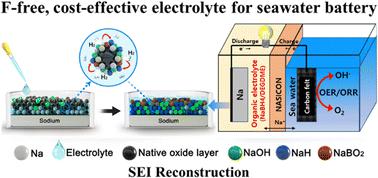当前位置:
X-MOL 学术
›
Energy Environ. Sci.
›
论文详情
Our official English website, www.x-mol.net, welcomes your
feedback! (Note: you will need to create a separate account there.)
Designing fluorine-free electrolytes for stable sodium metal anodes and high-power seawater batteries via SEI reconstruction
Energy & Environmental Science ( IF 32.4 ) Pub Date : 2022-08-25 , DOI: 10.1039/d2ee01295b Jinuk Kim 1 , Jioh Kim 1 , Jooyoung Jeong 1, 2 , Jiwon Park 3 , Cheol-Young Park 1 , Sewon Park 1, 4 , Shin Gwon Lim 5 , Kyu Tae Lee 5 , Nam-Soon Choi 1 , Hye Ryung Byon 3 , Changshin Jo 2, 6 , Jinwoo Lee 1
Energy & Environmental Science ( IF 32.4 ) Pub Date : 2022-08-25 , DOI: 10.1039/d2ee01295b Jinuk Kim 1 , Jioh Kim 1 , Jooyoung Jeong 1, 2 , Jiwon Park 3 , Cheol-Young Park 1 , Sewon Park 1, 4 , Shin Gwon Lim 5 , Kyu Tae Lee 5 , Nam-Soon Choi 1 , Hye Ryung Byon 3 , Changshin Jo 2, 6 , Jinwoo Lee 1
Affiliation

|
Fluorine (F) is regarded as a key element in electrolytes for sodium metal anodes (SMAs) because of the formation of NaF containing solid–electrolyte interphase (SEI) layers; however, the high-cost and HF formation issues experienced by F-based electrolytes should be addressed. Herein, F-free, cost-effective 1 M NaBH4/ether-based electrolytes are proposed, motivated by the recent speculation that NaH is a “good SEI layer.” The time-of-flight secondary ion mass spectrometry (TOF-SIMS) results of sodium metal electrodes after galvanostatic cycling demonstrated that NaH is a major component of the SEI layer. In addition, the native oxide surface of sodium was converted into NaH and NaBO2 after soaking in the electrolytes, implying that “SEI reconstruction” occurred by chemical reduction. Accordingly, significantly longer cyclability was obtained in the Na‖Na symmetric cell (1200 h, 1 mA cm−2, 1 mA h cm−2) than in F-based electrolytes. In seawater batteries (SWBs), 1 M NaBH4/DEGDME (diethylene glycol dimethyl ether) delivers higher power density (2.82 mW cm−2 vs. 2.27 mW cm−2) and cyclability (300 h vs. 50 h) under 1 mA cm−2 than 1 M NaOTf/TEGDME (tetraethylene glycol dimethyl ether), which is commonly used in SWBs. In conclusion, two novel contributions of this study include the demonstration that NaH can work as a “good SEI layer” apart from NaF and the proposal of a cost-effective, F-free electrolyte for practical and large-scale SWBs.
中文翻译:

通过 SEI 重建设计用于稳定钠金属负极和大功率海水电池的无氟电解质
氟 (F) 被认为是钠金属阳极 (SMA) 电解质中的关键元素,因为它会形成含 NaF 的固体电解质界面 (SEI) 层;然而,应解决 F 基电解质所经历的高成本和 HF 形成问题。在此,由于最近推测 NaH 是“良好的 SEI 层”,提出了不含 F、具有成本效益的 1 M NaBH 4 /醚基电解质。恒电流循环后钠金属电极的飞行时间二次离子质谱 (TOF-SIMS) 结果表明,NaH 是 SEI 层的主要成分。此外,钠的天然氧化物表面转化为 NaH 和 NaBO 2浸泡在电解液中后,暗示“SEI重建”是通过化学还原发生的。因此,在 Na‖Na 对称电池(1200 小时,1 mA cm -2,1 mA h cm -2)中获得了比 F 基电解质显着更长的循环能力。在海水电池 (SWB) 中,1 M NaBH 4 /DEGDME(二甘醇二甲醚)在 1 mA 电流下提供更高的功率密度(2.82 mW cm -2 对2.27 mW cm -2)和可循环性(300 小时对50 小时)厘米-2大于 1 M NaOTf/TEGDME(四甘醇二甲醚),通常用于 SWB。总之,这项研究的两个新贡献包括证明 NaH 可以作为除 NaF 之外的“良好 SEI 层”,以及为实用和大规模 SWB 提出具有成本效益的无 F 电解质。
更新日期:2022-08-25
中文翻译:

通过 SEI 重建设计用于稳定钠金属负极和大功率海水电池的无氟电解质
氟 (F) 被认为是钠金属阳极 (SMA) 电解质中的关键元素,因为它会形成含 NaF 的固体电解质界面 (SEI) 层;然而,应解决 F 基电解质所经历的高成本和 HF 形成问题。在此,由于最近推测 NaH 是“良好的 SEI 层”,提出了不含 F、具有成本效益的 1 M NaBH 4 /醚基电解质。恒电流循环后钠金属电极的飞行时间二次离子质谱 (TOF-SIMS) 结果表明,NaH 是 SEI 层的主要成分。此外,钠的天然氧化物表面转化为 NaH 和 NaBO 2浸泡在电解液中后,暗示“SEI重建”是通过化学还原发生的。因此,在 Na‖Na 对称电池(1200 小时,1 mA cm -2,1 mA h cm -2)中获得了比 F 基电解质显着更长的循环能力。在海水电池 (SWB) 中,1 M NaBH 4 /DEGDME(二甘醇二甲醚)在 1 mA 电流下提供更高的功率密度(2.82 mW cm -2 对2.27 mW cm -2)和可循环性(300 小时对50 小时)厘米-2大于 1 M NaOTf/TEGDME(四甘醇二甲醚),通常用于 SWB。总之,这项研究的两个新贡献包括证明 NaH 可以作为除 NaF 之外的“良好 SEI 层”,以及为实用和大规模 SWB 提出具有成本效益的无 F 电解质。











































 京公网安备 11010802027423号
京公网安备 11010802027423号